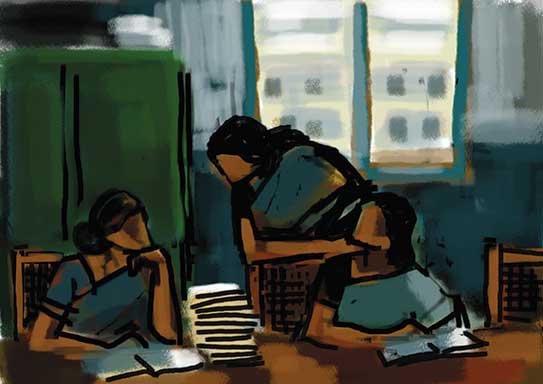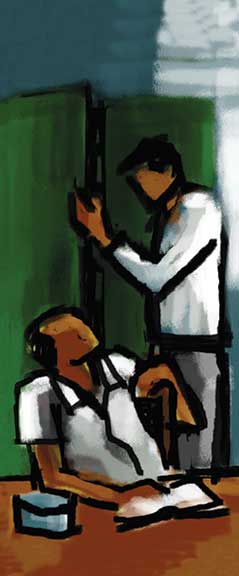Sunita Biswas
The phone ringing nonstop… students at the door …groans of “The printer’s not working again!”… some people with their heads down in determined work, others in a heated discussion about how best to penalize students AWOL (Absent without leave) the day before a test, a sudden exclamation of “Oh no, I forgot about my duty at lunch time!”, someone on an inspection of available snacks, a different group debating the merits of online shopping….a disembodied and disgusted shout “Ladies why can’t you use the washroom without flooding the floor?” … and then the triumphant entry of a bearer of news…. “The D.A. (dearness allowance) has come!!!” Instantly everything else is forgotten and the staff room has become the happiest place!
How does one define a staff room? It is that mysterious space in a school that does not need a sign to say Do Not Enter or Trespassers Will Be Prosecuted. The staff room door, a portal to another dimension, has made every student wonder what exactly goes on behind it. It is a part of a teacher’s workplace, and like any other workplace, it is a microcosm of society. There are all kinds of people who are brought together in an extremely demanding, high-accountability job that requires minute planning and preparation, yet needs flexibility and adaptability to tackle unpredictable not-in-the-lesson-plan situations. And, at all times, tickling the consciousness of the teacher is the thought that today’s classroom interaction will perhaps impact tomorrow’s outcome. The staff room then becomes a critical breathing space for a teacher and equally a place where she freely airs her views on subjects ranging from school timings to Salman Khan.

In defence of my way
Just as there are all kinds of schools, there is a whole range of staff room types to be found across schools. Schools with multiple staff rooms and schools with none. In some countries there is a dedicated area for work only, where the atmosphere is busy, professional and formal, and a separate space, sometimes called the lounge, where teachers have their lunch and interact with each other in a more relaxed way. In India we are more familiar with a large room where a sizeable number of teachers attempt to work and relax and, of course, interact with one another.
If we were to start with the raison d’être of every teacher in a school – teaching – the staff room is where she plans and prepares for lessons, sets papers, marks assignments, prepares reports and does a lot more. There is always some deadline to be met and work invariably expands to fill time. In all of this some definite “types” emerge on the basis of individual working style. Some believe in promptness and getting things done and out of the way. Others like to live dangerously and put off completion till the deadline-induced panic sets in. These two types can irk each other leading to some heated defence of “my way”. Collaboration and sharing of resources, which is an important aspect of the work of teachers, usually conducted in staff rooms, can become another slippery area. Resource-sharing ought to be spontaneous and generous, but there are instances when this becomes an issue akin to copyright infringement.
Some teachers enjoy varying their teaching strategies and trying out new things in the classroom; and there are those who prefer to stick to the tried and tested. And once again this gives rise to remarks especially aimed at the first group and “creative” suddenly becomes a bad word! Extra duties too are an eternal subject of discontent. There are the perpetual moaners crying ‘unfair’ and airing dark comments about partisan treatment, and the ‘escape committee’ who display a special talent at ducking extra work or time. Pitted against them are the earnie-bernies hoping to score brownie points by being available for all the extras. And all the while there are some who store all these responses in the mistaken conviction that knowledge is power.
Top of the pops
Students (and sometimes their parents) are often a major topic of teacher talk. This is not necessarily always a bad thing. As long as value judgments are not passed and labels are not stuck on with Fevicol, a colleague’s comments can help a teacher understand a student better by giving her a different perspective that might have been overlooked. So since teachers will talk about students, taking conscious care to stay positive is perhaps the key. The myth goes that teachers’ perpetually badmouth their students. In fact what is perhaps a more unfortunate aspect of student-manipulation is the severely felt need by a teacher to establish how popular she is with her students. And if you are not able to bring back to the staff room anecdotal evidence of your enviable rapport in class (or outside), then you have failed as a teacher.
 Staff rooms can have designated or free seating. Both have their pitfalls. In a designated seating space there will always be heartburn over who got the window and who got the air conditioner with the vents pointing in the desired direction. Or who by virtue of her seat next to the door has to attend to every stray student looking for a teacher. The intercom is another sore case in point here. The teacher sitting next to the phone will periodically announce the number of calls she has already answered in the ONLY free time she had, and that she will not take any more calls. A free seating arrangement is actually a misnomer and a potential minefield for a new teacher because sacrosanct, proprietary rights have been established over the “best” seats (and the coffee mugs and the crockery-cutlery) in an unspoken code of “always” that must be adhered to.
Staff rooms can have designated or free seating. Both have their pitfalls. In a designated seating space there will always be heartburn over who got the window and who got the air conditioner with the vents pointing in the desired direction. Or who by virtue of her seat next to the door has to attend to every stray student looking for a teacher. The intercom is another sore case in point here. The teacher sitting next to the phone will periodically announce the number of calls she has already answered in the ONLY free time she had, and that she will not take any more calls. A free seating arrangement is actually a misnomer and a potential minefield for a new teacher because sacrosanct, proprietary rights have been established over the “best” seats (and the coffee mugs and the crockery-cutlery) in an unspoken code of “always” that must be adhered to.
Coffee mugs and crockery brings us to the delectable topic of food. The lunch break is when the staff room hums with chatter and clatter. As the lunch boxes come out and food is shared with a what-have-you got-today, there is the same enthusiasm and anticipation that is found among the students. Of course there will be the health-conscious and the diet die-hards, and the four course (including dessert) fans, and each group will look askance at the others’ plates and think (and sometimes say) how can she eat so much/so little? Special days, like birthdays and even family celebrations, bring special treats which are joyously given and tucked into with delight. One might observe here that the celebrations for certain teachers become more marked than for others. Sometimes the entire staff room decides it deserves a treat and orders food in. And woe betide the teacher who takes on the responsibility of deciding the menu and…horror… collecting the money! Until the food is delivered and everyone has got just what she ordered, the said teacher remains on tenterhooks. A curious thing noted by many teachers in many schools is the systematic disappearance of cutlery!
The same lack of basic etiquette whether displayed in the thoughtless use of the washrooms or cell phones or in judgmental remarks about dress and physical appearance and even social and relationship status can put a strain on interactions. This strain can give rise to groups and cliques and become situations of passive-aggressive bullying. These issues can become extra sensitive if both men and women share the same space. Though the general consensus here is that a mixed staff room is definitely a lot more fun!
And finally, at the end of the month, an sms pops up to announce ‘Your account has been credited with…’! Sighs of relief punctuated with peanut metaphors can be heard. Not too loudly because who talks about money when one is answering ‘a calling’? But the sotto-voce salary-talk, rife with arch speculation about one’s own colleagues and wistful comparisons with other schools, float across the room. For the most part these dangling conversations remain within the confines of the staff room because one does not want to risk being labeled ill-bred or greedy or, the worst slur of all, money minded! But the deep-seated conviction of being a hapless, exploited martyr unites in an unspoken bond!
Morale-building place
The ‘inside stories’ of staff rooms that I gathered were reassuringly similar. However, every staff room is different. You may feel a distinct reserve on entering one, while another rings with boisterous laughter, with someone periodically shouting “Quiet!” above the din. It is said that the ethos of a school is discernible from its staff room. When staff rooms function as a family, valuing each other, sharing each other’s joys and sorrows, supporting each other, and forging friendships for life, the increased productivity reflects in the performance of the entire school. It then falls upon the principal and designated teacher-leaders to ensure that staff room friction, and attempts at leveraging, are eliminated through clear instructions, consistency and above all empathy. A staff room that is a happy, morale-building place is largely so because of the efforts of the school principal who leads in absentia without actually being present in the room.
The teachers’ staff room is a space with endless possibilities for fascinating journeys. And members of this exclusive club should work at celebrating differences and rising above them. Wishing all teachers a happy staff room experience, I end on a somewhat irreverent but relatable note with Diana Gooding, a teacher in Northumbria, who said “It’s a happy staff room when no one hears the bell.”
The author teaches at Modern High School for Girls, Kolkata. She can be reached at sunceebee@gmail.com.
Related Articles
The staff room: Sanctuary or stressor?
Faculty meetings: Look how productive they are!
